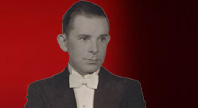

![]()
“Fifty-One Faces North ” (1955)
This exploration of Stewart James now arrives at two locked doors. The sign on one door reads “The Board Room;” the other is labeled “51 Faces North.” This first room represents the magician’s most closely guarded creative strategy; the second contains the secret explanation of a trick, which James kept hidden until he passed away in 1996. “The Board” consisted of Stewart James and individuals he referred to as “the three companions who never were” (ES 195 ). Rigonally, Faxton and Khardova began as imaginary friends who helped young Stewart cope with the loneliness of childhood. And just as the isolation he experienced from an early age onwards was unusually strong, so was his connection to these three companions. As he hesitatingly confided in a letter to Paul Montgomery for the first time in 1949, his imaginary friends did not disappear once he grew older; in fact, his communication with them became “increasingly satisfactory” (ES 192). Sitting down at the “talking” table with Rigonally, Faxton and Khardova became a highly beneficial way for James to focus his creative powers and to engage in complex intellectual critique of his thoughts on specific magic tricks. This method for creative inspiration is reminiscent of the automatic writing William Butler Yeats, Jack Spicer and other poets have used as a way to access ideas from beyond their conscious minds. The difference being that James was perfectly aware that his companions were figments of his imagination, not voices from beyond. He found his frequent meetings with “The Board” to be exhilarating and an irreplaceable source of new ideas, but he was certainly self-conscious about his habit. In another letter to Montgomery, James expressed relief that “the possibility that I may be an intermittent paranoic is not going to dissuade you from corresponding” (ES 76). Fortunately, from the 1950s onward, the middle-aged magician became less inhibited about discussing his more bizarre creative strategies. He often openly shared the material produced during his meetings with Rigonally, Faxton and Khardova, and grudgingly spoke about the imaginary ritual he practiced with them when prompted. He even turned over notes and other records concerning the “Deepsters” to Allan Slaight as they prepared Stewart James in Print. When the book was finally published (in 1989), and Slaight began work on The James Files, Stewart James was eighty-one years old. He was satisfied that his oeuvre was being published, but he declined to have anything about his imaginary collaborators printed. On more than one occasion he feared that he “might lose contact with them if they were the subject of a published article” (ES 194). Even so, the voluminous release of his life work still coincided with the ultimate departure of Rigonally, Faxton, and Khardova. James lost touch with the latter two of his trio during the 1980s and the intense process of putting together Stewart James in Print. It is difficult to know how to interpret this change in his imaginary life, but an eventual retreat of his first and oldest confidant – Rigonally (named after the adjective “originally”) – appeared imminent. As Allan Slaight states in The Essential Stewart James, James avoided becoming as involved in the second enormous collection of his material. He told his editors: “I want to spend more time with Rigonally or I’m afraid that I might lose contact with him . . .” (ES 196). This disturbing connection between the publishing of his creations and the perishing of his fictive friends may explain why the magician never published one of his most famous card tricks. “51 Faces North” might have been one of those innovations, which James felt so closely attached to that he preferred to keep it confidential. Perhaps by opening the door to his personal boardroom, even if it was only to a select group of individuals, he somehow compromised or at least rendered less intimate his relationships with Rigonally, Faxton, and Khardova. Sending “51 Faces North” to the magic press would also mean releasing a private creation to the public. Still, at different times, from the late 1950s onward, James released tidbits of information about the trick and piqued the interest of countless magicians. In the legendary card effect, a spectator freely chooses to deal one card facedown, the rest of the deck face-up and then discovers that the solitary facedown card matches a prediction made in advance. Accompanying this impressive description, the innovator sent out a list of what seemed like impossible restrictions. That list, similar in concept to the one he used for “Vocalculate,” became a creative challenge for many of the top minds in magic. In 1978, an entire booklet studying possible solutions for the trick – Cards 2-51 Faces North – was published by Karl Fulves. Despite multiple requests, Stewart James refused to reveal his secret explanation. Sadly, sometime in 1992, James held his last meeting with Rigonally and never saw him again. Only four years later, the then 88-year-old magician also left this world for good. Knowing that the invention of magic tricks and the exploration of alternate realities were his passions in life, one can only hope that on his last imaginary journey he traveled to the inspirational Shangri-La he once described. After his death, at least one questioned remained: Would the mystery of “51 Faces North” ever be solved?
|
Copyright © 2007 Joe Culpepper and Magicana. All rights reserved.